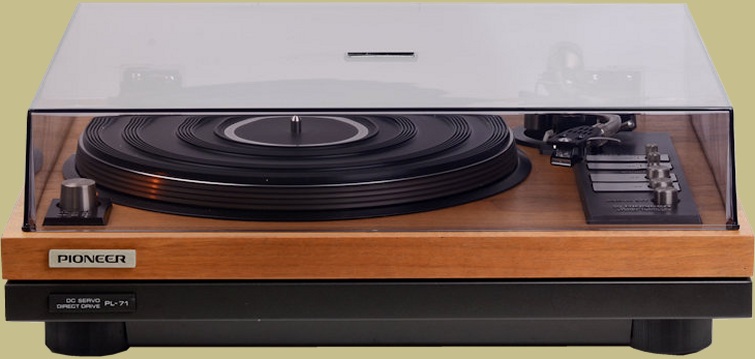
In 1974 the Pioneer PL-71 hit the market at a retail price of roughly $300. It’s a fully manual turntable and was Pioneer’s top-of-the-line at the time. It’s a beautiful and elegantly designed turntable with a double construction plinth with a wood cabinet, finished in real walnut veneer, and a black metal bottom base. The controls are simple and easily accessible. The table is powered on via the On-Speed buttons. Just push the correct button for the speed you want and the table will power on.
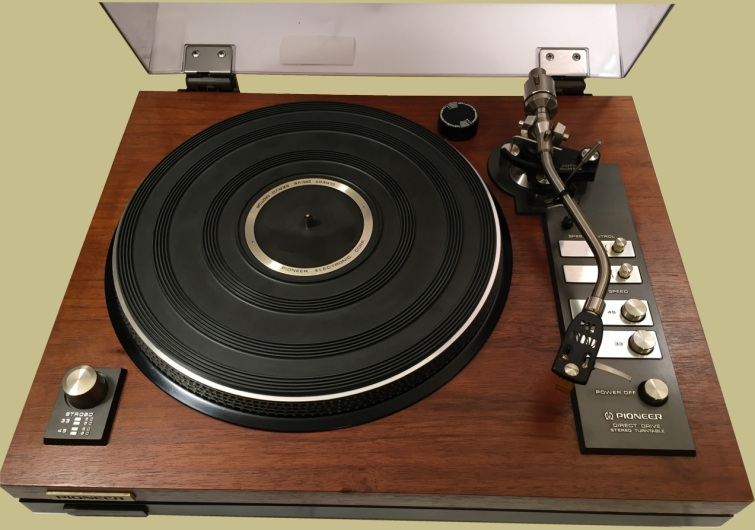
The Pl-71 is a direct drive or DC servo controlled direct drive system. Its brushless DC motor rotates the platter without a belt or idler. This results in less vibration and therefore less noise or rumble. The platter is die-cast aluminum alloy and is 12 1/4″ (31cm) in diameter.
On the left of the turntable is the strobolight which is used in conjunction with the stroboscope bumps on the side of the platter. It can be switched to 33 or 45. The strobe bumps are from top to bottom:
- 33 1/3 50Hz
- 33 1/3 60Hz
- 45 50Hz
- 45 60Hz
To adjust the speed press the corresponding speed button (on-speed) at the right of the table. Check the strobe and adjust by rotating the speed control knobs. The speed can be adjusted +/- 2% for fine tuning.
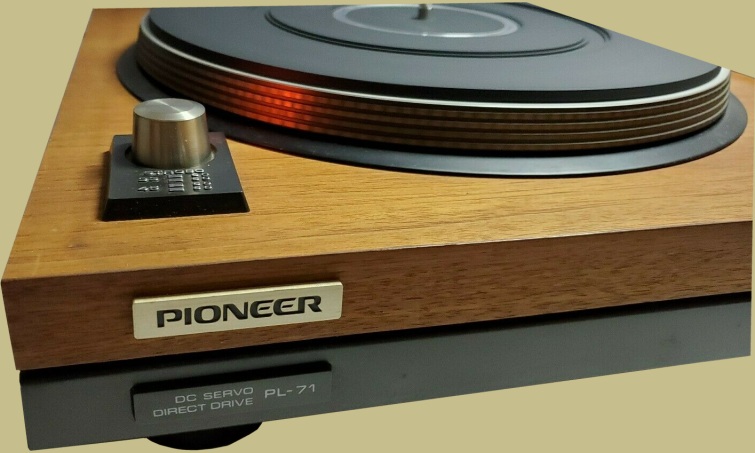
Specifications:
- Type: direct drive
- Motor: brushless DC servo controlled motor
- Speeds: 33 and 45rpm
- Speed control range: within +-2%
- Wow and flutter: 0.05%
- Rumble: more than 60dB
- Platter: 310mm aluminium alloy diecast
- Tonearm: static-balance type, s-shaped pipe arm
- Effective length: 224mm
- Overhang: 14.5mm
- Cartridge weight range: 4 to 32g
- Dimensions: 480 x 185 x 415mm / 18 29/32 x 7 9/32 x 16 11/32
- Weight: 11kg / 24lb 4oz
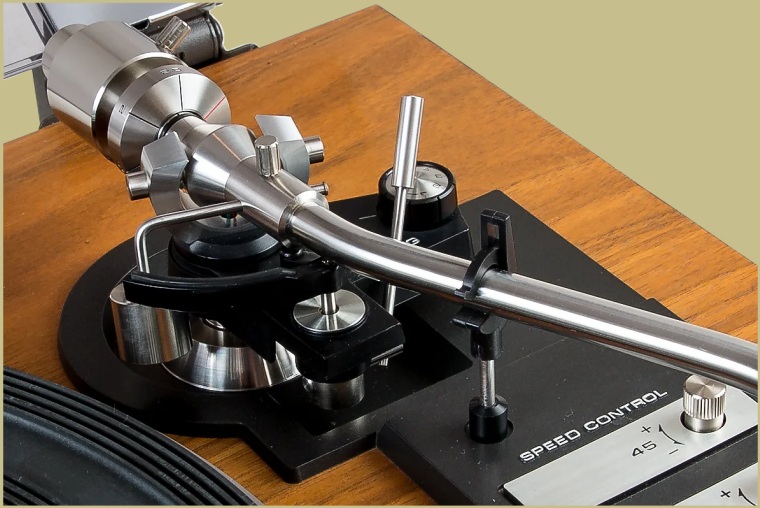
The counter weight compensates for cartridges in the range of 4 to 32 grams. The Pl-71 has a lateral balancer, anti-skating control, direct-readout stylus pressure scale and an oil-damped cueing device.
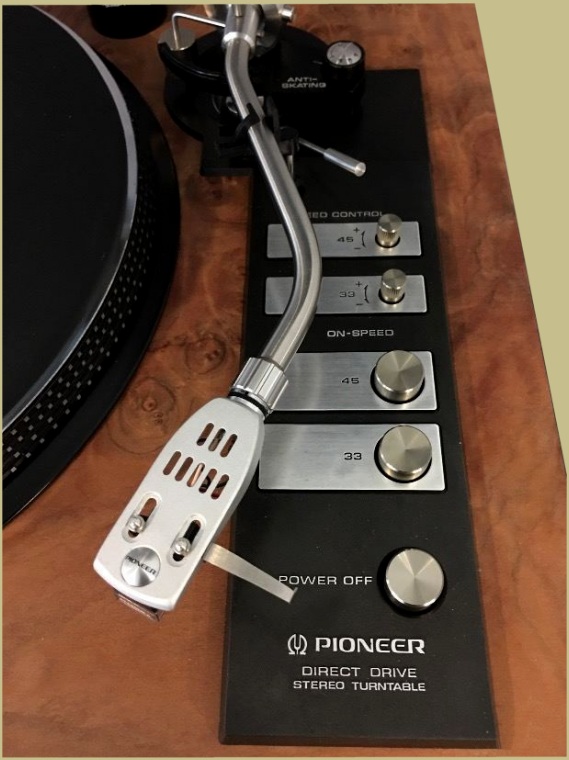
The tonearm on the Pioneer PL-71 is an S-shaped, medium mass, stainless steel tonearm designed for light tracking pressure. The tube is 0.5mm thick with an outer diameter of 9mm. The light weight headshell is a plug-in style with a rubber damper. Stylus overhang can be adjusted via the overhang gauge printed on the 45 record adapter. The PL-71 also has adjustable VTA.
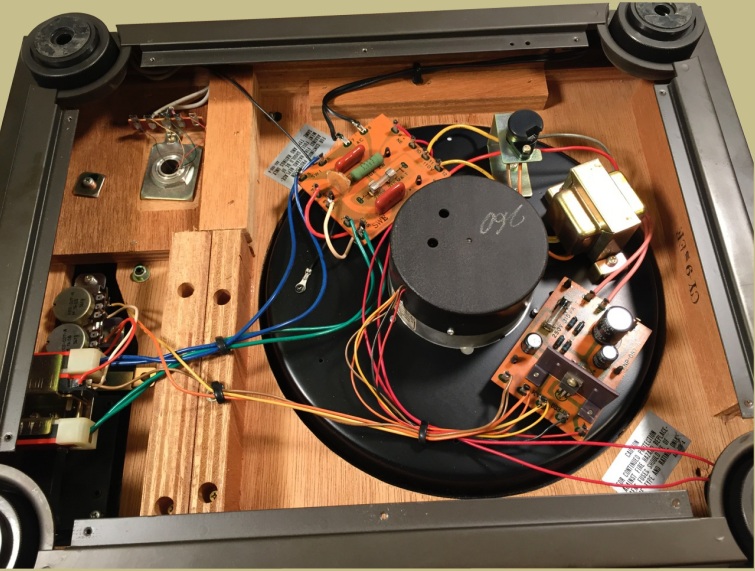
One issue with the Pioneer PL-71 is that the cue arm fluid tends to dry out over time but this is a fairly easy fix. Another is that they sometimes have speed control issues which can usually be resolved by either cleaning the pots or replacing leaky capacitors.
Notice that PL-71 has detachable RCA leads which is nice. The semi-transparent dustcover has spring loaded hinges so that the cover can be arrested in any position. It can also be removed from the hinges altogether.
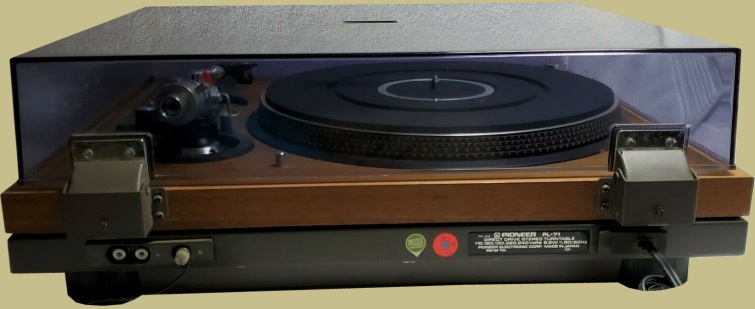
The Pioneer PL-71 is a great turntable. It’s easy to set up and easy to use. It looks fantastic too. It’s definitely one of the best looking turntables Pioneer ever made. Manual turntables aren’t for everyone but if you like the interaction between user and turntable then it’s perfect. The PL-71 has a heavy, solid, non-suspended plinth and will be less sensitive to room setup issues. It’s really a set-it-and-forget-it type of turntable. The direct drive motor is quiet and reliable and you’ll never have to replace a belt. So, if you’re looking for an easy to use, great looking turntable that performs at a very high level then the PL-71 is for you.

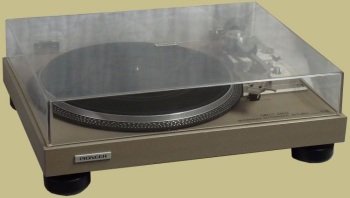
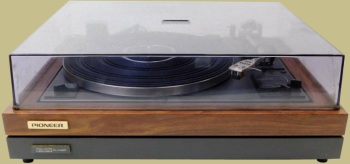
I have this turn tables but the needle broke. Can I purchase any kind or what do you recommend. Also I have no speakers for them. What speakers do you recommend also?
It depends on what cartridge you have on the the tonearm. It’s possible the cartridge has been changed at some point. Usually the cartridge model is printed on the front or side. Once you know that you can look up the model on google and find what stylus will work with it. Most any speakers will work but if you don’t have a stereo receiver to amplify the signal coming from the turntable then you’ll either need to get one or get a preamp. There are small, inexpensive preamps for sale for around $30. They take the weak signal from the turntable, amplify it, and then send it to the speakers. Some of them have no volume control though. You can use a small amplifier too. I use an Optimus SA-155 amplifier for my garage setup and it works well. If you already have a stereo receiver with a Phono input then you won’t need anything else. Speaker selection is dependent upon the power output of your stereo or amplifier, space considerations and budget, but most any speakers will work. with a small amplifier (like the Optimus) you’ll want to use small speakers. I have small bookshelf speakers that I use with mine. For larger speakers you’ll want a full size amplifier or stereo.
The model number on the pick up cartridge should help you identify the stylus. Unscrew the head shell and you should be able to read the manufacturer and model number.
Speakers are so personal that I would recommend you go listen to some!
I take it you already have a receiver/amplifier. I certainly wouldn’t recommend anything costing $30!
I used to work for Pioneer when this model was current and it was the one I chose for personal use!
I have this turntable paired with an SA-7500 Stereo Amp. I just finished listening to the 4 record set of Mike Oldfield boxed and am comfortably numb from the experience. This remix of his first 3 Albums is ethereal. No pops or crackles. Just about to research how to get quad from the turntable into 5.1.